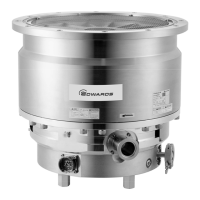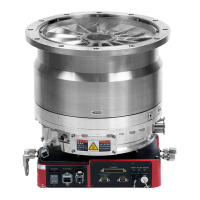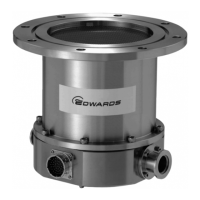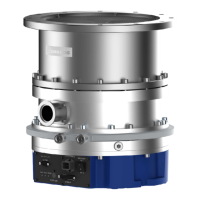STP Series Turbomolecular Pump
MAINTENANCE AND INSPECTION
6.2 Cleaning
The method for cleaning the STP pump is as follows:
• Clean the outside of the STP pump with proper solvent as required. An alcohol solvent can be
used.
• Clean off with a pure gas when dust has accumulated in the connector.
• If the label of the STP pump has been damaged, contact Edwards.
The decontamination (overhaul) in the STP pump is executed in Service office. When an overhaul is
needed, contact Service office.
6.3 Inspecting the deposit
WARNING
Deposit may have accumulated inside the TMP depending upon the type of process
tool and process gases. If periodic overhauls are not conducted then excessive
build-up of deposit inside the TMP may in rare cases lead to a malfunction or the
following failure modes:
・ Rotor breakage due to contact of the rotor with the deposit.
・ Damage of process chamber and valve due to ejected rotor debris.
・ Damage of cooling water lines due to shock from rotor breakage.
On certain processes, rotor contact with deposit can lead to chemical reaction
between the deposit and aluminium powder generated from the rotor. This may
result in abnormal combustion and sudden pressure increase.
Damage may be caused not only to the TMP but also the vacuum equipment where
the TMP is installed and the surroundings.
For devices in which deposit accumulates, conduct daily inspection along with
periodical overhaul.
Leaving the STP pump without removing the deposit may cause the STP pump to
be corroded beyond repair. After removing the pump, contact the service office and
immediately send the pump to the service office.
Note: As stated in the Disclaimer, the costs of troubleshooting problems resulting from deposit will
be at your own charge even during the warranty period.
In a periodic inspection, by watching the pump outlet port, inspect the inside of the outlet port and the
pump interior for adhesion of deposits. Although the setting needs to be made for periodic
inspections depending on the use conditions, conduct a periodic inspection once every three to six
months under normal conditions. If deposit has accumulated to some extent, an overhaul (cleaning)
is required. Contact Service office.
Contact with the atmosphere may cause a reaction of the deposit. Seal the inlet port, outlet port, and
purge port so as to prevent the deposits from being exposed to the atmosphere as much as possible.
For the transport method, see Section 6.5, "Transporting for repair or overhaul".

